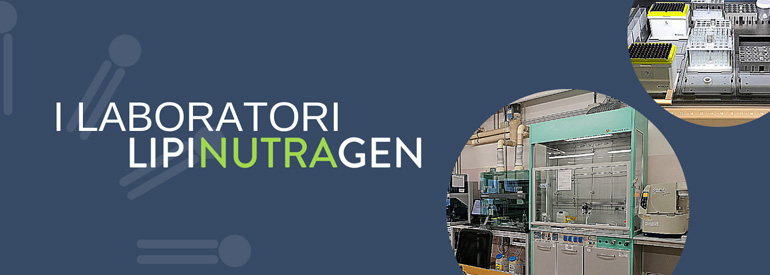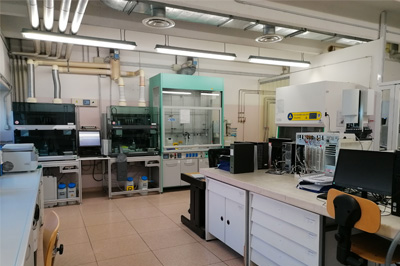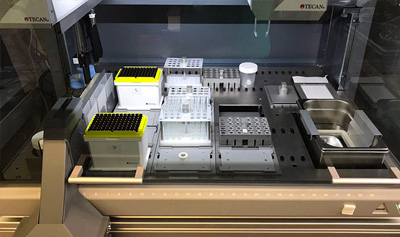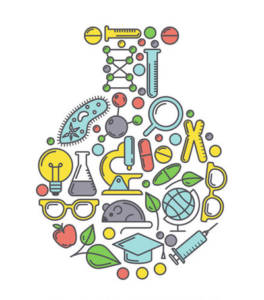
THE LIPINUTRAGEN LABORATORIES
WHAT IS A HUMAN HEALTH ANALYSIS LABORATORY:
Before talking about our laboratories, let’s enforce what a chemical-clinical analysis laboratory is.
It is a particular chemical laboratory where analyzes are carried out on biological material of various types from patients, in order to identify and measure the presence of molecules that have a connection with health.
These laboratories are the executive arm of “laboratory medicine” which evaluates people’s health through the results of the tests. We can speak of Centers dedicated to the activity of taking and/or analyzing biological samples, or of Laboratories within larger structures, such as a hospital, a clinic or a research institute. They are classified according to the technological level of the investigations carried out (general laboratories, specialized laboratories) and are divided into sectors and fields of study.
The employees who work in these structures are qualified to carry out the duties to which they are assigned, and to name a few, in the Laboratory you must find the figures of: Director (graduate in medicine or biology or chemistry), Laboratory analyst (graduate in medicine or biology or chemistry), laboratory technician (diploma graduates or university graduates in scientific subjects), etc.
All analytical laboratories in the health sector must request and obtain authorization from the competent health authority, which certifies compliance with the minimum structural and management requirements, to perform the declared activities.
THE LIPINUTRAGEN LIPIDOMICS LABORATORY:
 Lipinutragen, founded in 2005 as a spin off initiative of the CNR of Bologna, has over the years become a national and international reference in the sector of Lipidomics, a branch of molecular medicine that approach with lipids (commonly called fats).
Lipinutragen, founded in 2005 as a spin off initiative of the CNR of Bologna, has over the years become a national and international reference in the sector of Lipidomics, a branch of molecular medicine that approach with lipids (commonly called fats).
In particular, when it comes to lipidomics, it is also necessary to specify which sample or biological part the lipids are examined, to understand what the diagnostic value of the analysis is. Membrane lipidomics focuses on the cell membrane, which is essential to life as it surrounds and delimits all the metabolic machinery of the cell, and lipidomic analysis is dedicated to the recognition and quantification of fats, called phospholipids in technical terminology, contained in the membrane.
Cell membrane lipidomics:
Lipinutragen was born to spread the application of scientific knowledge on the cell membrane, and has developed the paradigm of the mature red blood cell membrane (MRBC), as a fundamental element to be examined to have knowledge about the nutritional and metabolic status of individuals and to use the lipidomic profile as a global biomarker of health status.
Science supports the choice of MRBC as a cell representative of health conditions as it is the one most produced by our organism (80% of the new replacement cells produced every day). In particular, the membrane of the MRBC is representative of the state of fats present in the body.
 The experimental methodology based on scientific expertise has always been Lipinutragen’s distinctive innovation. In 2012 Lipinutragen developed the industrial analytical process, perfecting the LNG-R1 robotic equipment, a unique technological innovation in the world in the field of lipidomics: analysis cycles of 24-48 samples (whole blood in EDTA) and the robotic reliably and replicability carries out all the phases of cell selection, isolation and membrane extraction to obtain the sample on which to perform the analytical profile of saturated, monounsaturated and polyunsaturated fatty acids.
The experimental methodology based on scientific expertise has always been Lipinutragen’s distinctive innovation. In 2012 Lipinutragen developed the industrial analytical process, perfecting the LNG-R1 robotic equipment, a unique technological innovation in the world in the field of lipidomics: analysis cycles of 24-48 samples (whole blood in EDTA) and the robotic reliably and replicability carries out all the phases of cell selection, isolation and membrane extraction to obtain the sample on which to perform the analytical profile of saturated, monounsaturated and polyunsaturated fatty acids.
ASL authorization and accreditation:
Our Lipidomics Laboratory is authorized by ASL (Aut. San. PG 263274 of 08/11/2012) for the execution of molecular diagnostics, and in particular for the erythrocyte membrane lipidomic analysis. The Laboratory uses a (Management System) aimed at promoting the creation and maintenance of customer confidence in the activities of the Company and the Laboratory itself, as well as the impartiality and integrity of the technical operations associated with them (for more information visit the page https://www.lipinutragen.it/en/about-us/the-lipidomic-laboratory/).
In 2020 Lipinutragen achieved a further milestone regarding the entire process of Lipidomic Analysis (from the sample acceptance and preparation phase to the issue of the Test Report, or the outcome): certification according to the UNI CEI EN ISO / IEC 17025: 2018 by the single body for accreditation, ACCREDIA.
This very important step, the result of a process of harmonization and study, has allowed Lipinutragen to certify – thanks to an external audit – the characteristics of precision, reliability and repeatability of its MEM_LIP1 Analytical Method (accreditation article link https://www.lipinutragen.it/en/iso-iec-17025-accreditation/). This method is so far the only one in the world for cell membrane analysis certified by an internationally recognized Accreditation Body. The practice dictates that those who intend to offer analyzes of this type on the market must conform to the certified method, to give the consumer the maximum guarantee of the product’s quality.
Scientific Research: LIPINUTRAGEN’s “FUEL for INNOVATION”
Scientific Research has always been the fuel for innovating the Company’s products. Lipinutragen was in fact born from the idea of two CNR researchers who from experiments and field studies have identified in the membrane lipidomics of mature red blood cells a scientifically consolidated approach that can be brought to the market, to increase the health and well-being of society. With this approach, in its 15 years of life, Lipinutragen has actively engaged in the spreading, in particular among health professionals (Pharmacists, Doctors and Nutrition Biologists), of the lipidomic culture and the correct use of molecular medicine knowledge in field of lipid diagnostics.
Our R&D & I Laboratory:
 Our R & D & I team participates in international and national research projects (for more information visit the page https://www.lipinutragen.it/en/about-us/research-projects/), and conducts observational and clinical studies in collaboration with medical units of national and international importance for the application of lipidomic analysis in human health. The results are also published in scientific journals of international importance, and represent Lipinutragen’s contribution to the scientific progress of the sector (some of these at the rear end of the article).
Our R & D & I team participates in international and national research projects (for more information visit the page https://www.lipinutragen.it/en/about-us/research-projects/), and conducts observational and clinical studies in collaboration with medical units of national and international importance for the application of lipidomic analysis in human health. The results are also published in scientific journals of international importance, and represent Lipinutragen’s contribution to the scientific progress of the sector (some of these at the rear end of the article).
Our company promotes innovations for the development of new and advanced methods and applications of lipidomics in the clinical field.
In the nutraceutical field, Lipinutragen has created an R&D&I project and a dedicated Laboratory, present in the Innovation Accelerators of the CNR Research Area in Bologna, to develop a very innovative approach in nutraceuticals: based on the lipidomic profiles collected in the company database, specific active ingredients are identified for the human profile of interest, and new formulations are developed that guarantee the achievement of the active cell membrane site, or with a proven bioavailability of the active ingredients to intervene on lipid imbalances. The recent application of micro emulsions with high bioavailability of DHA (www.lidha.it) and the birth of the NUTRAOMIC® Supplement Line are two examples of the development achieved by this Laboratory.
This laboratory is equipped with vanguard equipment to examine the composition and quality of nutraceutical raw materials.
Scientific publications produced by Lipinutragen in collaboration with national and international research groups:
• Cohen G, Riahi Y, Sunda V, Deplano S, Chatgilialoglu C, Ferreri C, Kaiser N, Sasson S. Signaling properties of 4-hydroxyalkenals formed by lipid peroxidation in diabetes. Free Radic Biol Med. 2013 Dec;65:978-987. doi: 10.1016/j.freeradbiomed.2013.08.163. Epub 2013 Aug 20. PMID: 23973638.
• Sansone A, Tolika E, Louka M, Sunda V, Deplano S, Melchiorre M, Anagnostopoulos D, Chatgilialoglu C, Formisano C, Di Micco R, Faraone Mennella MR, Ferreri C. Hexadecenoic Fatty Acid Isomers in Human Blood Lipids and Their Relevance for the Interpretation of Lipidomic Profiles. PLoS One. 2016 Apr 5;11(4):e0152378. doi: 10.1371/journal.pone.0152378. PMID: 27045677; PMCID: PMC4821613.
• Ferreri C, Masi A, Sansone A, Giacometti G, Larocca AV, Menounou G, Scanferlato R, Tortorella S, Rota D, Conti M, Deplano S, Louka M, Maranini AR, Salati A, Sunda V, Chatgilialoglu C. Fatty Acids in Membranes as Homeostatic, Metabolic and Nutritional Biomarkers: Recent Advancements in Analytics and Diagnostics. Diagnostics (Basel). 2016 Dec 22;7(1):1. doi: 10.3390/diagnostics7010001. PMID: 28025506; PMCID: PMC5373010.
• Pironi L, Guidetti M, Verrastro O, Iacona C, Agostini F, Pazzeschi C, Sasdelli AS, Melchiorre M, Ferreri C. Functional lipidomics in patients on home parenteral nutrition: Effect of lipid emulsions. World J Gastroenterol. 2017 Jul 7;23(25):4604-4614. doi: 10.3748/wjg.v23.i25.4604. PMID: 28740349; PMCID: PMC5504376.
• Amézaga J, Arranz S, Urruticoechea A, Ugartemendia G, Larraioz A, Louka M, Uriarte M, Ferreri C, Tueros I. Altered Red Blood Cell Membrane Fatty Acid Profile in Cancer Patients. Nutrients. 2018 Dec 1;10(12):1853. doi: 10.3390/nu10121853. PMID: 30513730; PMCID: PMC6315925.
• Jauregibeitia I, Portune K, Rica I, Tueros I, Velasco O, Grau G, Trebolazabala N, Castaño L, Larocca AV, Ferreri C, Arranz S. Fatty Acid Profile of Mature Red Blood Cell Membranes and Dietary Intake as a New Approach to Characterize Children with Overweight and Obesity. Nutrients. 2020 Nov 10;12(11):3446. doi: 10.3390/nu12113446. PMID: 33182783; PMCID: PMC7696547.
• Jauregibeitia I, Portune K, Gaztambide S, Rica I, Tueros I, Velasco O, Grau G, Martín A, Castaño L, Larocca AV, Di Nolfo F, Ferreri C, Arranz S. Molecular Differences Based on Erythrocyte Fatty Acid Profile to Personalize Dietary Strategies between Adults and Children with Obesity. Metabolites. 2021 Jan 8;11(1):43. doi: 10.3390/metabo11010043. PMID: 33435565; PMCID: PMC7827034.
Article by the Editorial team of Lipinutragen
The information given must in no way replace the direct relationship between health professional and patient.
Photo: 123RF Archivio Fotografico: 49513396 ©betelgejze / 123rf.com
- On 1 February 2021



